Best Places to Visit in Anuradhapura
How about a one week trip to sense the archaic fascination in the first planned city of Sri Lanka? In 1982, UNESCO declared several areas of Anuradhapura city as a world heritage site The first historic capital of the country gives a blush of a stately, well-rendered pre-Christian metropolis of gigantic Buddhist shrines. This is not only Buddhist shrines but, monasteries, magnificent palaces, parks, bathing ponds, reservoirs, and pavilions. Those astonishing masterpieces of architecture the first historic capital of Sri Lanka accompanied by engineering technology, art, the sculpture will offer lifetime travel highlights.
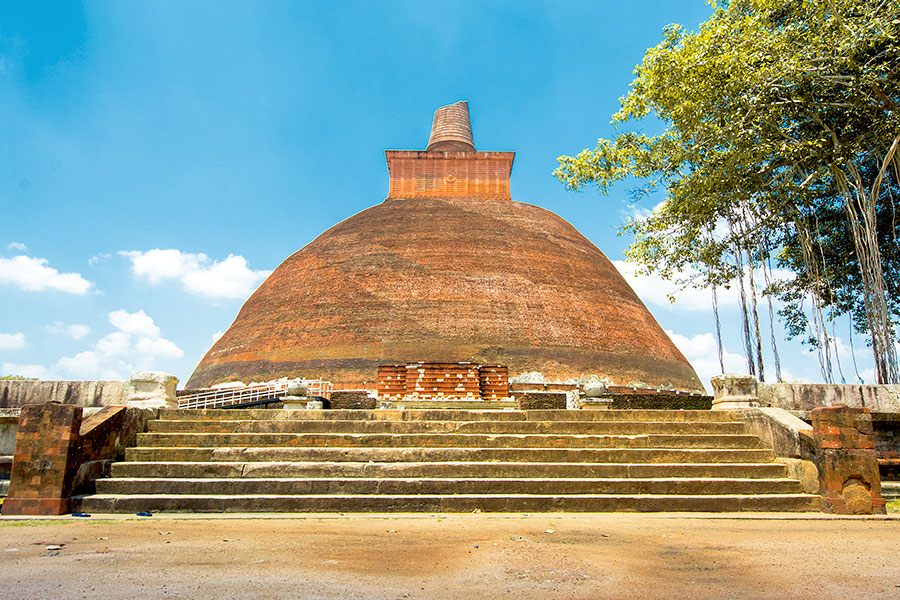
Anuradhapura the first capital of Sri Lanka, situated in the North Central province of the island. It was the capital for more than 130 kings. The center of Theravada Buddhism is dating back 5th century BC was the royal seat of Sri Lanka for over 1400 years. Thuparama dagoba, Isurumuniya rock temple, and the 2200 years old Sri Maha Bodhi – the sacred Bo tree had become the world’s most aged historical tree ever. Abhayagiri stupa and two Jetavanaramaya stupa which are lesser in height only to great pyramids in Gizeh and the ancient irrigation system will be mind-blowing for viewers.
The fashion of Anuradhapura city has been unique itself with the enormous pagodas, immense reservoirs which have been made by doyen kings who governed the city in that era. Monumental pinnacles, mammoth tanks characterize the marvels of traditional Sri Lankan engineering technology. Not only that, incredible rock carvings and the incomparable scenic beauty adds the area an extraordinary value. Colossal stone pillars, ruins of ancient royal palaces, Buddhist monasteries, temples are remained showing the old glory for the visitors. Amazing stone made swimming pools append the originality of hydrolytic technology in ancient Sri Lanka.
Weather in Anuradhapura
Anuradhapura is usually hot and humid all along the year with an average temperature between 25-30 degrees Celsius. April becomes the warmth month with 34 degrees Celsius while January becomes the coldest. Rainfall occurs throughout the year while high levels are recorded in October, November, and Mid May.
Are you planning to Visit Anuradhapura?
Check out the places we recommend you to visit on your trip to Anuradhapura.
Ruwanwelisaya
One of the greatest, one of the 16 pieces of veneration, this enormous construction which is associated with inexplicable, cosmological, and geographical mysteries in Sri Lanka. The standing majestically neighborhood of Anuradhapura city. Ruwanwelisaya is built by King Dutugamunu in 140 BC after defeating Chola king Elara. A large portion of Gauthama Buddha’s relics has enshrined inside an inner chamber. It is considered to be the largest collection of relics of Gauthama Buddha anywhere in the world. The most treasured place to be worshiped for Buddhists, hoarding expensive gems, gold, silver in the basement of the Stupa.
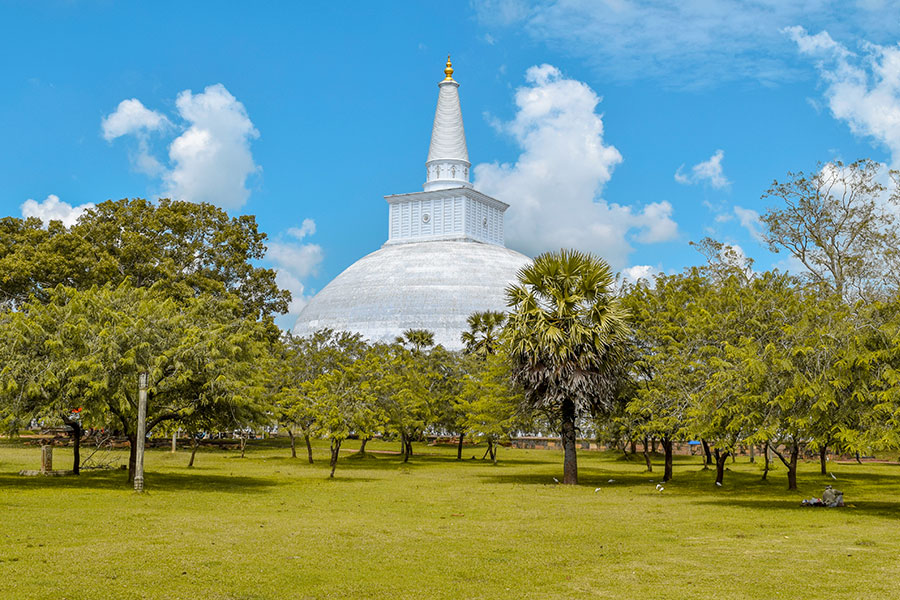
The chronicles reveal a beautiful story beyond having the name, Swarnamali Chaitya. Arahat Mahinda Maha Thero scattered a bunch of jasmines. The land trembled as a large Stupa is going to be made on the site. The beautiful goddess Swarnamali was dwelling in a Ran Thelambu tree in the particular site. And she was agreed to leave the place if the Stupa is built on her name. The king has agreed and created a colossal fabrication naming Ruwanwelisaya (Swarnamali Stupa).
The original Stupa renovated in the early 20th century, increasing the height. This is the most adored, most venerated most sacred Stupa in Sri Lanka ever after. Buddhists all over the world worshiped and sacrificed the Dagoba over centuries beyond. This large hemispherical construction is one of the world’s tallest, ancient monuments, with a vertical height of 103m and a circumference of 290m. This is indeed a testimony of ancestral Sri Lankan architecture fused the endless devotion fused with excellent creativity.
Ruwanwelisaya Location on the Map
Jaya Sri Maha Bodhi
Lord Gauthama Buddha is considered to be the greatest human being appeared in the world. Equipped over many births, he obtained the Sambuddhathwa / the enlightenment seated under the shade of the Jaya Sri Maha Bodhi, 2600 years ago. That sacred tree, situated in Bodhgaya, India was destroyed by queen Thishyarakkha. Sri Maha Bodhi seated in Anuradhapura city is the southern branch of the original Bodhi tree which Gauthama Buddha is seated with his back against it. Therefore, the Jaya Sri Maha Bodhi can be considered the only relic of lord Buddha alive.
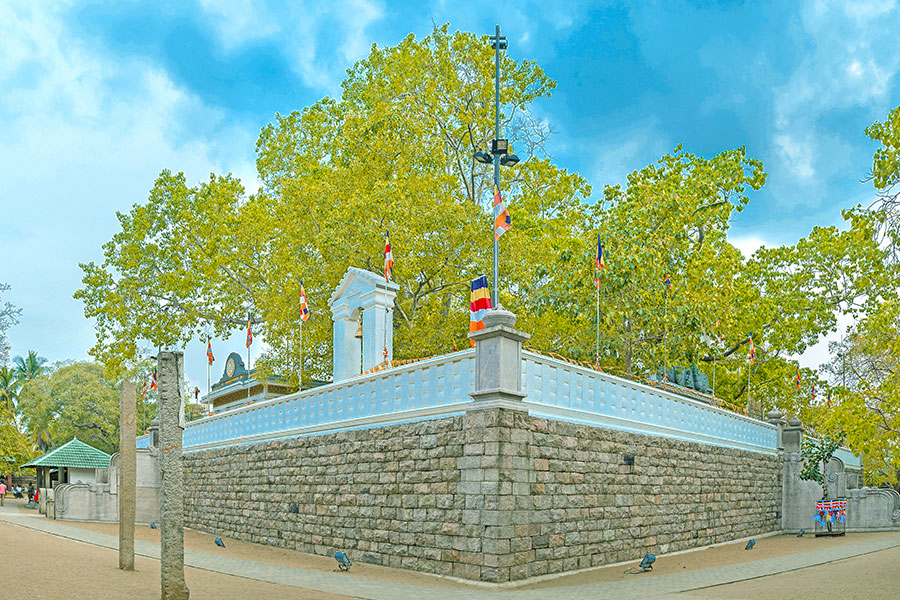
According to written facts, a scared Bodhi sapling of Jaya Sri Maha Bodhi in India had been ceremonially brought here by Arahath Sanghamitta Maha Theree. In 236BC, the sacred Bodhi sapling is planted by king Dewanampiyathissa at Anuradhapura and it’s shining over 2200 years up to now. Jaya Sri Maha Bodhi belongs to the family of trees, Ficus religiosa, named over the religious significance of it.
Jaya Sri Maha Bodhi is known as the oldest tree of the whole world with a written history. And it’s the main reason for UNESCO nominating areas of Anuradhapura as a world heritage. This holy tree is always free to worship without any hindrance. It is still being dwelling over thousands of years with endless venerations and devotion of the devotees along centuries representing live Buddha to the world wide Buddhists.
Jaya Sri Maha Bodhi Location on the Map
Abhayagiri Stupa
Are you interested in learning about major monasteries of Theravada and Mahayana Buddhism in ancient Sri Lanka? If your answer is “Yes”, Abhayagiri Viharaya in Anuradhapura will be your best choice. Surrounded by a voluminous pagoda, it is considered to be the original custodian of Tooth Relic. It’s either distinguished to have the most extensive ruins of great monasteries which are highly devoted by Buddhists as a nation.
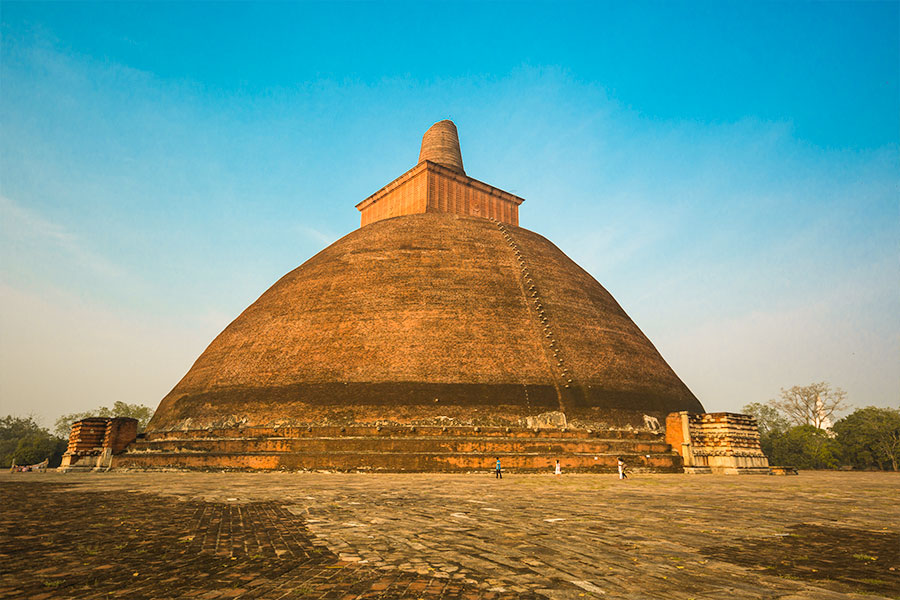
The second-largest Dagoba in Sri Lanka, massive Abhayagiriya carries significant importance in primitive Sri Lankan Sthupa creation. Dwells in the top portion among original Stupas, it still survives with the infinite grandeur after thousands of years. Endless harassments by the time factor, weather conditions, and negligence over centuries failed to fade its real originality. Gives us a glimpse of how it looked like in the good old days.
Abhayagiri dagoba belongs to the aramic complex of Abhayagiri temple constructed by King Valagamba in 1st century BC. The gigantic Sthupa stands at 75 meters up to the dome with a damaged spire. According to 5th-century traveler, Chinese monk Fa-Hsien’s writings, the Dagoba had been 122 meters in height. It had been adorned with silver, gold, and interspersed with jewels of all kinds. The Stupa is slumping nowadays, beclouded with grass and trees are grown on it more seems like a hillock other than a Stupa. The archeological department honestly takes a huge effort to renovate the Stupa. Unfortunately, the process is dimidiated due to a lack of funds.
Abhayagiri Stupa Location on the Map
Samadhi Buddha Statue
It is said, if you look at the face of the Samadhi Buddha Statue from three different sides it shows three different feelings! Looking at the face from the left side, it shows slight sadness, smiling face at the right view. Looking from the front view, it shows neutral feelings. This is considered to be an ingenious, almost lifelike, and thought-agitating work of art, incomparable to other statues.
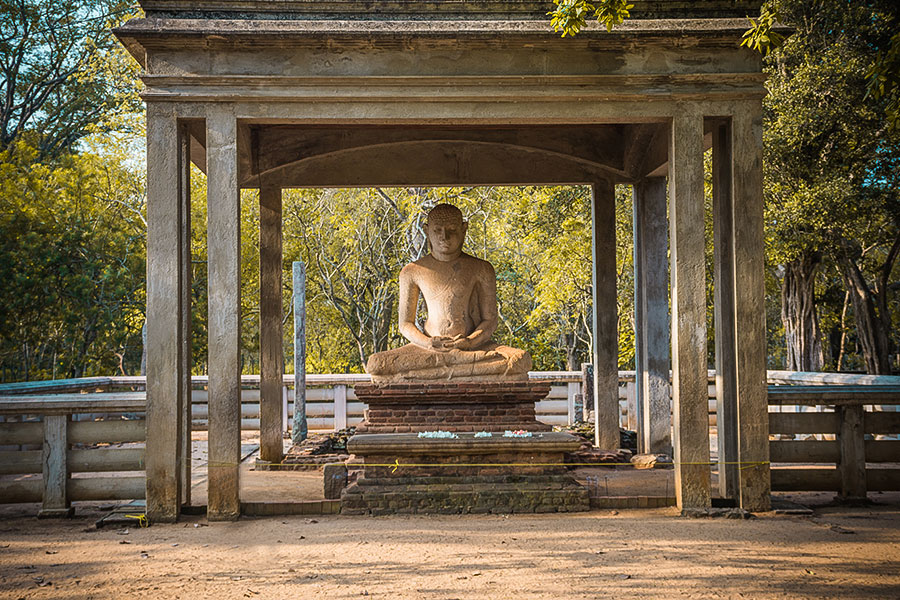
In the statue, Buddha is depicted in a posture of meditation adjoining with his Enlightenment. Buddha’s enlightenment is technically called Samadhi. Depending upon that philosophical allegiance, the statue may have named Samadhi Buddha statue.
Samadhi Buddha Statue in the Mahamewna park is a major landmark in the city of Anuradhapura. The original statue was made of Dolomite, dating back to 3rd or 4th AD, either the creator or sponsor remains unknown. It was destroyed by invaders and treasure hunters. The present statue was made of the same material created lately showing a meditative reflection with Dhyana Mudra and Veerasana posture.
This 7 feet height large statue is found damaged during the 19th century, the eye sockets are supposed to be embedded with gems or crystals. It is now heavily reconstructed as thought by many to have somehow lost its old glamour. The nose which is redone with cement and cement outer chamber seems to understate the original splendor. Somehow, this stone carved distinguish preformation is a masterpiece of past Sri Lankan stone engravers for another period.
Samadhi Buddha Statue Location on the Map
Isurumuniya
Antique Sri Lankan temple seems to have a huge connection with artistic sculptures. Attractive wood carvings and stone carvings are very much popular among ancient artists when creating monasteries. What do you think of a temple with beautifying stone carvings with a fascinating tank created by legendary kings in the neighborhood? Chilling! Right?
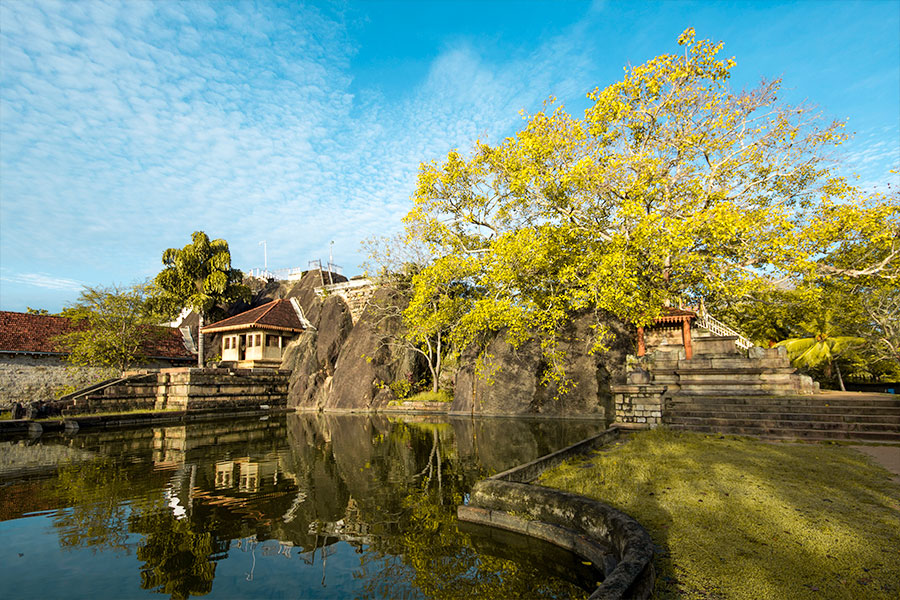
Isurumuniya is a well-known archaic temple that was constructed by famous King Devanampiyathissa in the Anuradhapura era. It is situated close to Thisa Wewa, connected to a cave, above a cleve. A small pagoda is built over there inside the temple with well-reputed stone carvings scattered everywhere. The horseman, Elephant Pond, the Royal Family, and the lovers are most adored among all of them.
As indicating the topic, Isurumuniya Lovers is the prominent creation of all. Some believed it to be a depiction of Prince Saliya of the heroic King Dutugamunu, and his girlfriend Ashokamala a poor maid. The prince gave up the throne over his pure love for her. Or a Hindu god Shiva and his goddess, Parvathi. The Bathing elephants make a remarkable impact on everyone who enters the temple, while Man and the Horse are somehow more enigmatic. A sitting man in a “King Posture” engraved to a rock face, next to a horse carving. The royal family is created on a granite plate with five royal-like human figures.
Isurumuniya temple is truly a place of romantic and serene setting which certainly will bring your experience of art to the next dimension.
Isurumuniya Location on the Map
Mihintale
Among many Asian countries, it’s very common to see religious places are situated in high altitudes. The devotees can be seen climbing the steps singing some folk music. Mihintale is a sequence of beautiful shrines and ancient caves that string across a wooded hill along 1840 steps over a mountain. This is usually crowded with votaries, white-robed pilgrims, and tourists. Local and foreign travelers keep the place busy all along the year with its unique religious value. It’s an auspicious place for all Sri Lankan Buddhists because it is revered as the birthplace of Buddhism in Sri Lanka.
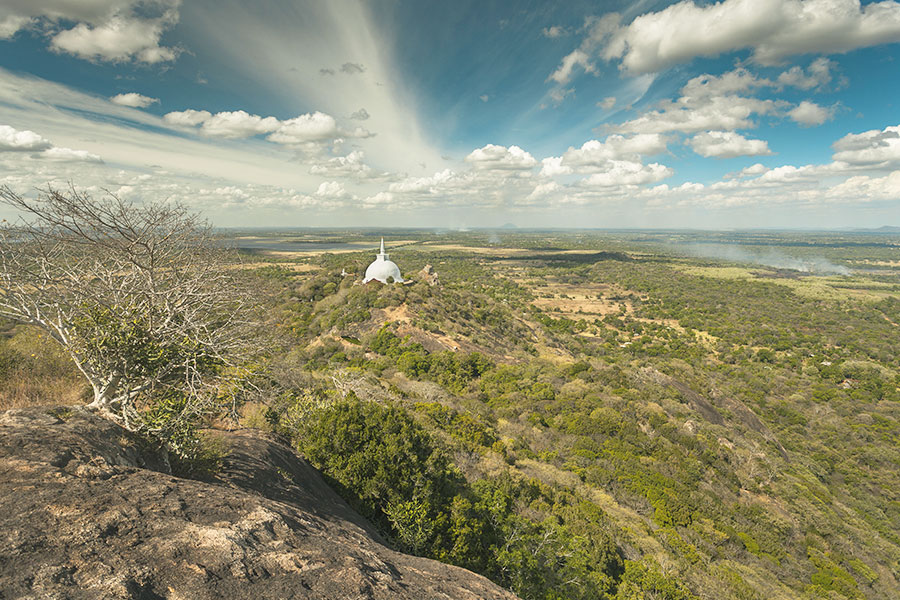
According to written history, in 247 BC Mahinda Arahath Maha Thero of India who is the son of a great Buddhist emperor Ashoka came across Buddhism in Sri Lanka. He met King Devanampiyathissa while he was hunting down a deer on the hilltop of Mihintale. The King was tested for his wisdom by the Thero and converted to Buddhism establishing Buddhism as the state religion of Sri Lanka.
In honor of that event at the hilltop, the first Buddhist monastery and Dagoba is built-in Mihintale enshrining the hair of Lord Buddha. The scenic beauty around the mountain top is fascinating when it’s blended with the ruins of caves, ancient ponds, and Dagobas. The caves were earlier used by monks who practiced meditation. Everyone who climbed to the temple is a bit disappointing to go down. Straggling with Sinhalese architecture, paintings, and sculptures, it becomes an unforgettable memory of their travel history forever.
Mihintale Location on the Map
Kaludiya Pokuna (Ancient Black Water Pond)
It is a complacent quiescent beautiful woods that clad begird the bolder environment which is a premier example of ancient Sri Lankan hydraulic prodigy. Water facilities for the monastic hermitages in the hilltop of Mihintale seem like the fact that brought about this impressive irrigation system established in this place. In this place, you can see a network of water channels that are connected to both natural and artificial ponds to build a proper and continuous water supply.
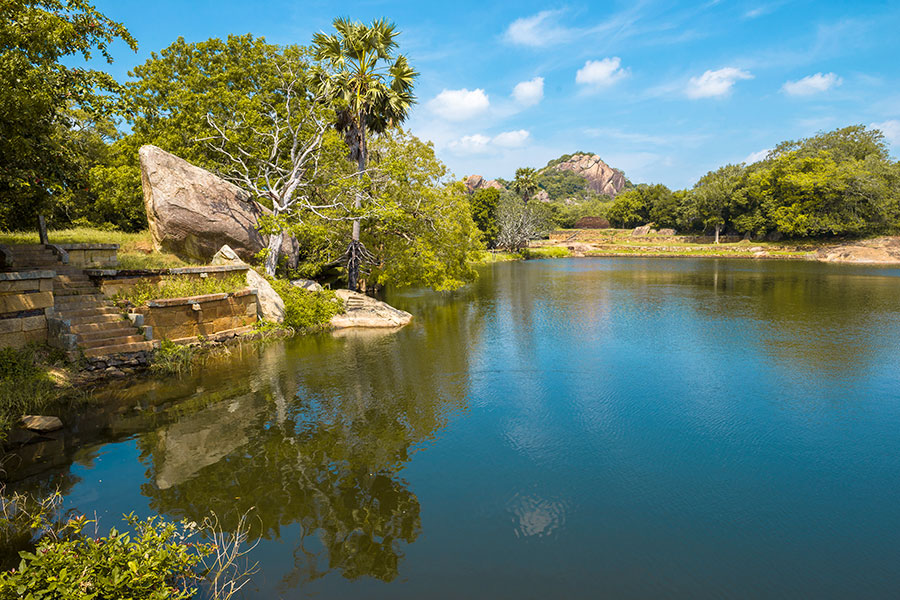
At present, there are no monks living there. But, yet has the historical value that stands as a witness of our forefathers’ skills in hydraulic engineering fused with the scenic beauty. The waterways from ponds patronize three ponds in the area. Even today some of them are identified to function as bathing ponds. They are Naga Pokuna, Sinha Pokuna, and Kaludiya Pokuna.
Kaludiya Pokuna or the Black Water Pond got its name due to the reflection of the trees, mountains, and huge boulder in the neighboring forest. It is nothing related to the water however, the water remains dark and silent all along the day. Around the pond, there is an Asrama and a Stupa where the monks gather to perform regular rituals. A cave-dwelling in a slight depression in the neighborhood adds significant serene beauty to the place. Smooth granite plates, bricks, and mortars near the pond are believed to be an old bathing room. All together makes the place worth watching at least once in your lifetime.
Kaludiya Pokuna Location on the Map
Ritigala Strict Natural Reserve & Forest Monastery
Ritigala mountain is a monastery that switched with many legends and myths. Very carefully laid out granite step tells us stories about back days when monks and anchorites contemplating refuge for meditative retreats. The maiden compact jungle is easy for peregrinating wild elephants, bears, leopards which is declared as a strict natural reserve. With the restricted human touch, the forest remains with its aesthetic beauty with the serene quiescent background. Especially, the upper part of this forest is well-known for rare flora and beautiful wild orchids.
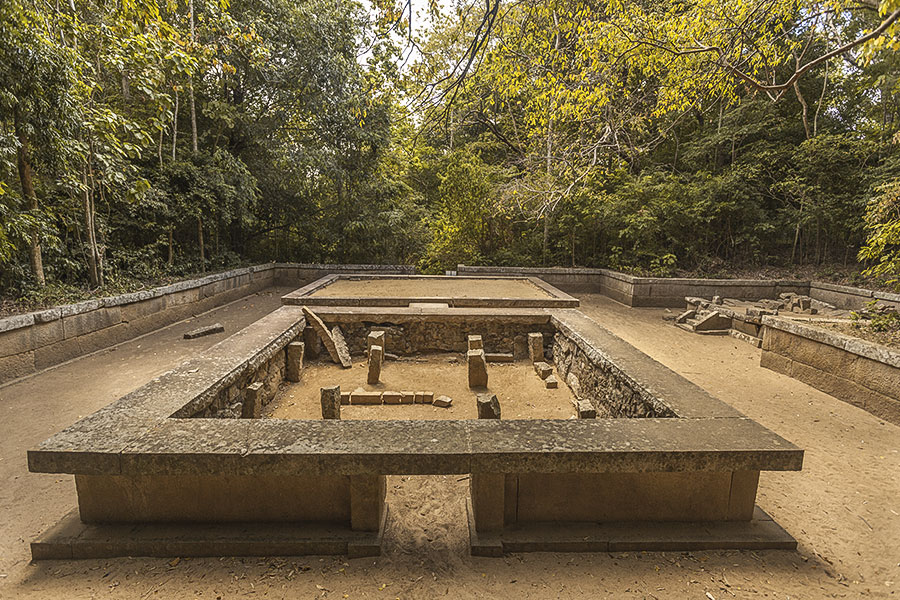
Ritigala mountain is home to about 70 rock caves which are scattered over 120 acres’ area. A short climb by foot off to the mountain takes the visitors to the ruins where is no human settlement nearby. The chronicles reveal Prince Prakramabahu hid in the jungle during his battle against his uncles. In another folktale, Lord Hanuman accidentally drooped here a chunk of the Himalayan mountain range that he was carrying from India to Sri Lanka to treat a fatal wound of Prince Rama. Also, Hanuman used Ritigala mountain as his launching pad to take the leap to India.
Ritigala mountain is home to a number of endemic plants endemic creatures including sloth bears and four species of wild cats. Monstrous spiders like Acramantulas with giant colorful centipedes and crawling copper and gold-skinned Salamanders are common on all surfaces of boulders. If you start a little early you won’t miss the most wonderful minutes of your life to feel the entire beauty of a tropical jungle.
Ritigala Strict Natural Reserve & Forest Monastery Location on the Map
Other important tourist places that you can visit along with Anuradhapura
Jethawanaramaya Dagoba
Kuttam Pokuna (Twin Baths)
Thuparamaya
Mirisawetiya
Rathna Prasadaya
Ranmasu Uyana (Royal Park)
Star Gate
Lankarama Dagaba
Lovamahapaya (Brazen Palace)
Archaeological Museum
Sandahiru Seya
Moonstone
Eth Pokuna (Elephant Pond)
Padhanagara
Kaparamula
Vessagiriya
Nuwara Wewa
Thissa Wewa
Thanthirimale temple
